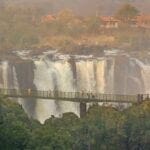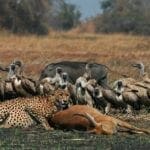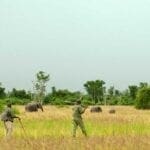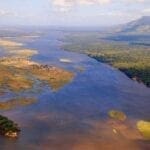The 3,369-square-kilometre (1,301 sq mi) Liuwa Plain National Park is in the Western province of Zambia. Until recently, the park was extremely difficult to get to and the access was completely dependent on the seasons. Therefore, it was not visited by many. However, a National Geographic video in 2010 about Liuwa’s last lioness (affectionately known as Lady Liuwa) after her entire family was wiped out by poachers has changed that. The documentary is about her incredible story of survival and loneliness. Since then, lions have been re-introduced to Liuwa and are doing quite well. But, this story and a few since, have raised awareness of this scenic wonderland, Liuwa Plain National Park.
Liuwa Plain National Park Uniqueness
The park is now becoming highly sort after due to it’s uniqueness. It resembles East African safari parks more than Zambian. This is due to its huge sweeping vistas and the second largest wildebeest migration in Africa; but without the crowds of Tanzania and Kenya’s migration.
It is also quite unique in that the Lozi tribe live in the park, moving to higher ground when the rains come in a celebratory festival. This means that zebras are sometimes seen with domestic cattle and the water pools with local fishermen. This adds to the uniqueness, special nature, and history of this magical place.
Other unusual antelope found include oribi, red lechwe, steenbok, duiker, tsessebe and roan. Jackal, serval, wildcat, wild dog as well as lion and hyena are the main predators of the area.
The area was designated as a protected area in the early 1880s by the then king/chief, Lubosi Lewanika. Although it became a national park in 1972, poaching became rife. Therefore, conservation organization, African Parks, in partnership with the Department of National Parks and Wildlife and the Barotse Royal Establishment has managed Liuwa since 2003. The Barotse Royal Establishment is monarchy of the Lozi people. This has led to increased local interest in preserving the park and its wildlife.
It is well worth visiting due to its spectacular scenery and wildlife. There is an abundance of birds, including the migratory species.
When to visit Liuwa Plain National Park
The Liuwa Plain is a photographer’s dream, with every season offering a different backdrop for capturing the robust wildlife. February to May is excellent for photographing dramatic storms and sunsets.
In mid to late October / November, the rainy season begins. Dramatic cloud formations erupt as the storms build, creating spectacular views. With the onset of the rains, carpets of flowers explode around the pans. Bird life* begins to flourish in every part of the park. This is also the time when large herds of blue wildebeest migrate across the plains from neighboring Angola. Wildebeest start having their calves and accompany large herds inside the park. The best predator action occurs during this time as hyenas prey on young wildebeest calves and vultures rush to the leftover carcasses. This lasts until around April by when most of the wildebeest and zebra have left the park.
The dry seasons, from May – mid/late October sees the lechwe’s congregate around the wetlands and wildlife is generally easier to see. This is because the grass dies down a bit and the vegetation thins out. Large flocks of cranes are abundant inside the park in May to July. Bird life is still abundant. Although most populations can be seen at the large fishing pools dotted around the plains of Liuwa.
The weather is cooler from May to July, warmer from August to October and the rains typically occur from November to April.
*Besides the wetlands, the plains are dotted with woodlands which also make for excellent birding. Liuwa is considered to be the fourth most important breeding site for wattled cranes.
Getting to Liuwa Plain National Park
A flight from Lusaka to Kalabo is approximately 2.5 hours or from Livingstone to Kalabo is only 1.5 hours. From there it is about a 3 hour drive will get you to the best camp, King Lewanika. Other community campsites may be closer or further but little used. Access from other destinations will be either via Livingstone or Lusaka.





















